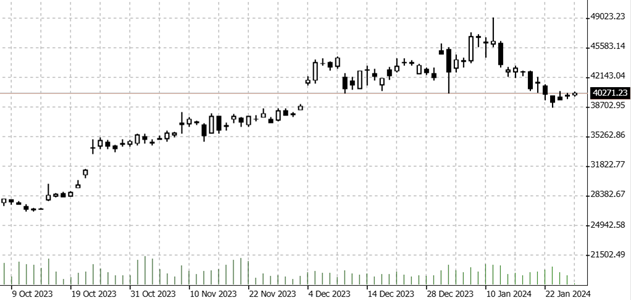

26.01.2024 – The dust has settled on Bitcoin, the hysteria following the major event has faded. And lo and behold: the authorisation for spot ETFs was, at least in the short term, an event blown up by big names and used to sell the news. The case is a lesson for everyone not to be driven by pushers. And how prices can be manipulated.
Dreariness instead of a rally: since 10 January and the approval of exchange-traded funds that are allowed to buy tokens on the spot market, BTC bulls have been disillusioned. The picture shows the daily chart. We had warned of a possible sell the news.

Source: Bernstein Bank GmbH
The new funds are certainly a success: the Bitcoin ETF from asset manager BlackRock is said to have already attracted one billion dollars, while Fidelity’s fund has received around 880 million dollars.
Sell the news
History is repeating itself, as Wirtschaftswoche recently noted: After the approval of futures ETFs on 19 October 2021, things initially went up. But one month after approval, the price had corrected by around 25 per cent.
What a lot of price forecasts there were. Let’s take a quick look back at those who beat their drums the loudest. Although it’s not all evening yet, there is a suspicion that it was precisely these pushers who sold their tokens to excited newcomers.
100,000 to 1,000,000
Adam Back, for example, head of the blockchain company Blockstream, had set a target price of 100,000 dollars – even before the index funds were launched.
The analysts at CryptoQuant have predicted that BTC will exceed the USD 160,000 mark. They also pointed to the upcoming halving and a boost for the stock markets in the wake of future interest rate cuts by the Federal Reserve. In other words, more risk appetite should also boost e-currencies.
Furthermore, Ash Crypto, a trader active on social media, predicted a price of USD 500,000 if the spot ETFs were approved.
Samson Mow, CEO of Jan3, a provider of digital infrastructure, even predicted a possible price of 1 million dollars. This is because the increased demand from institutional investors is offset by a relatively small supply of tokens.
So far, these mega-bulls have been so wrong. But what is not, can still be. Incidentally, BTC has recently been supported by the stock market crisis in the People’s Republic of China. According to Reuters, many Chinese have diverted capital into e-currencies out of fear of a crash. The question is what will happen if Chinese equities stage a sustained rally because Beijing is supporting the financial market. We are therefore curious to see what will happen with cryptos – we will keep you up to date.
_____________________________________________________________________________________________________________________________________
The content of this publication is for general information purposes only. In this context, it is neither an individual investment recommendation or advice nor an offer to purchase or sell securities or other financial products. The content in question and all the information contained therein do not in any way replace individual investor- or investment-oriented advice. No reliable forecast or indication for the future is possible with respect to any presentation or information on the present or past performance of the relevant underlying assets. All information and data presented in this publication are based on reliable sources. However, Bernstein Bank does not guarantee that the information and data contained in this publication is up-to-date, correct and complete. Securities traded on the financial markets are subject to price fluctuations. A contract for difference (CFD) is also a financial instrument with leverage effect. Against this backdrop, CFD trading involves a high risk up to the point of total loss and may not be suitable for all investors. Therefore, make sure that you have fully understood all the correlating risks. If necessary, ask for independent advice. CFDs are complex instruments and are associated with the high risk of losing money quickly because of the leverage effect. 68% of retail investor accounts lose money trading CFD with this provider. You should consider whether you understand how CFD work and whether you can afford to take the high risk of losing your money.7
